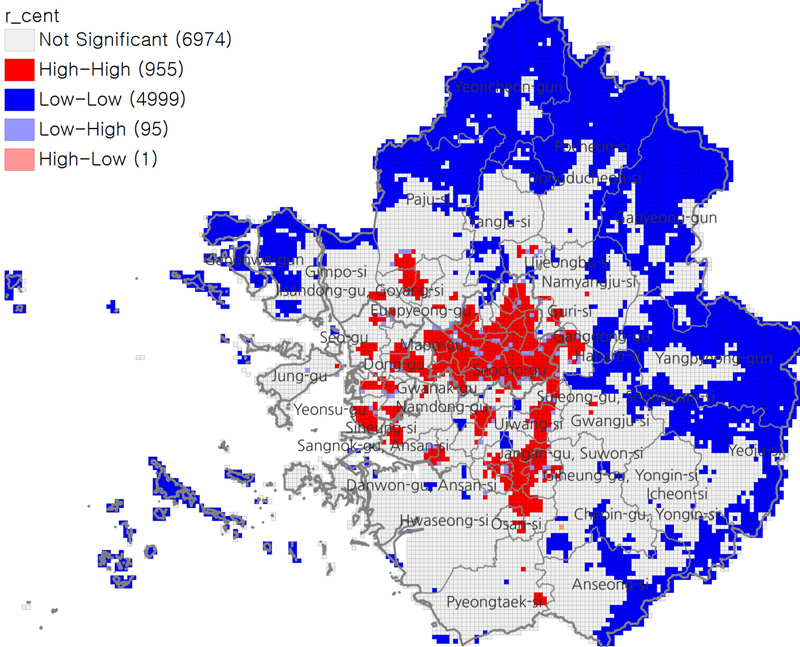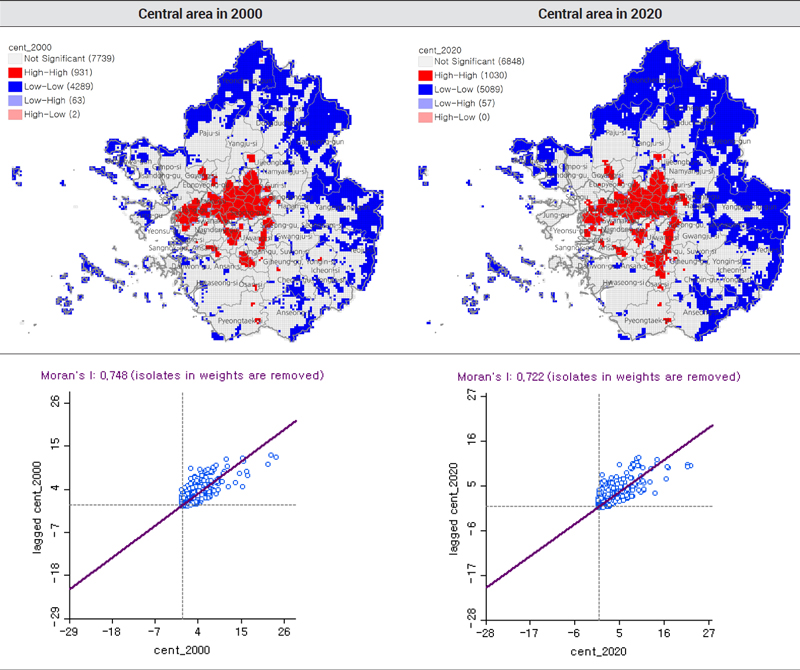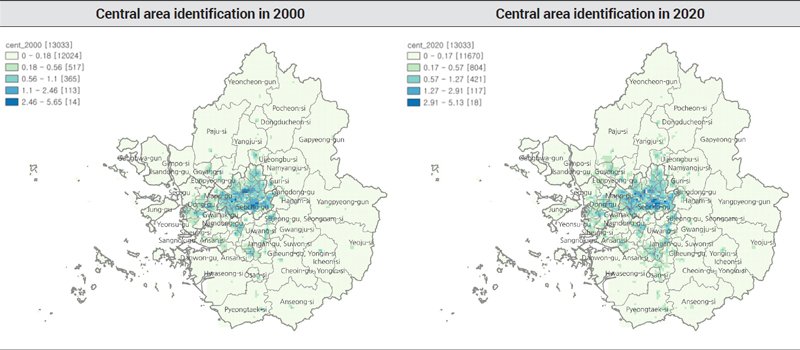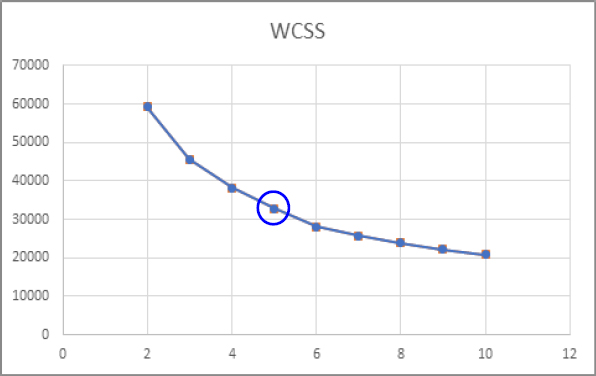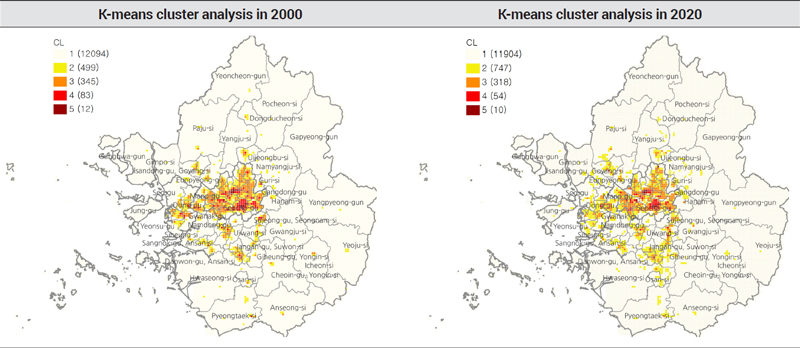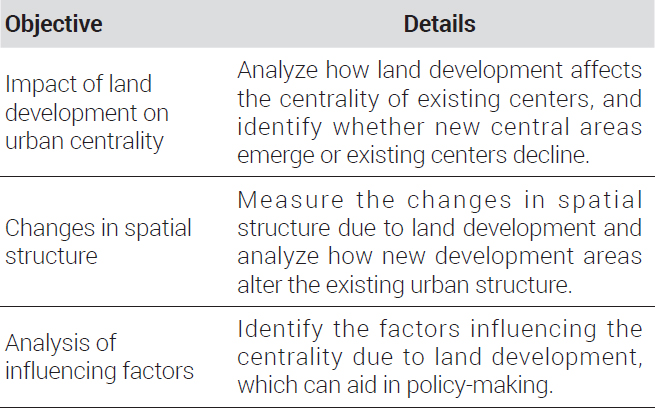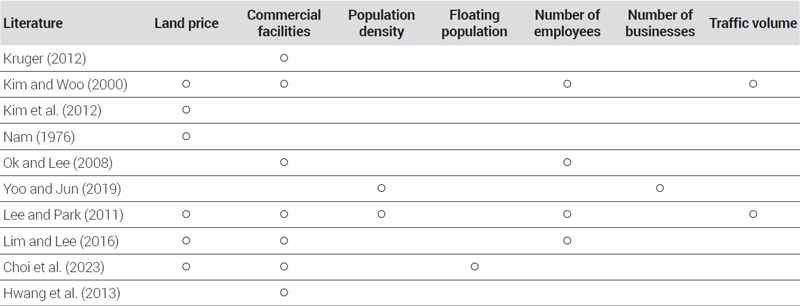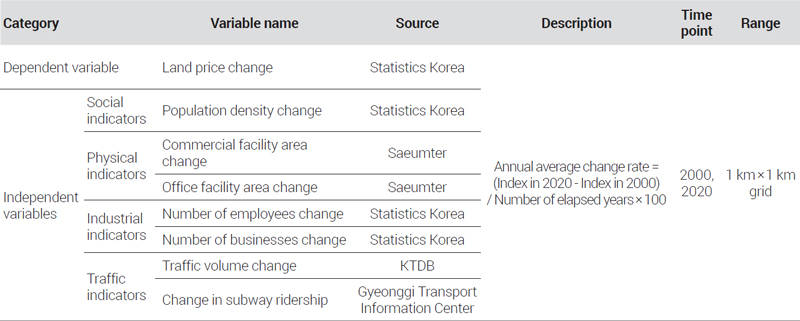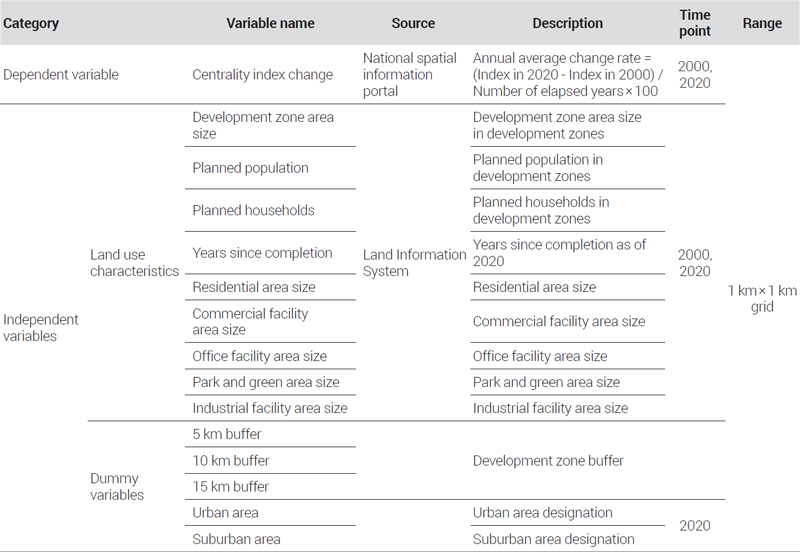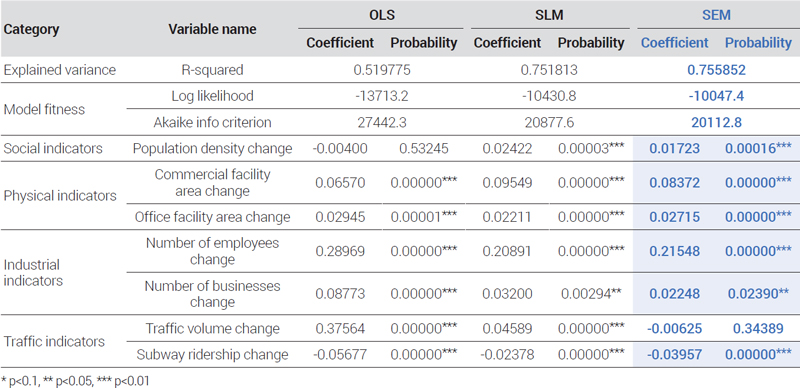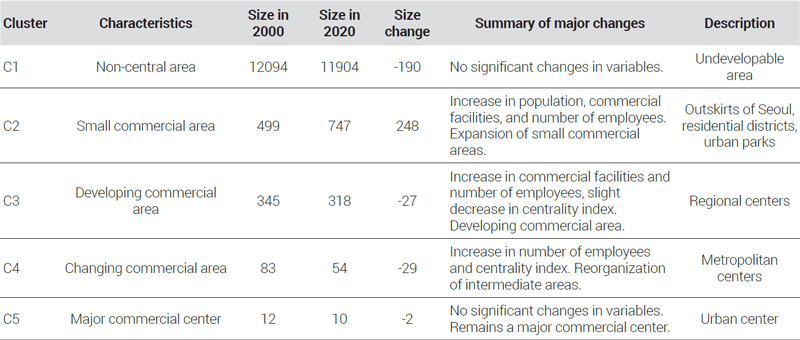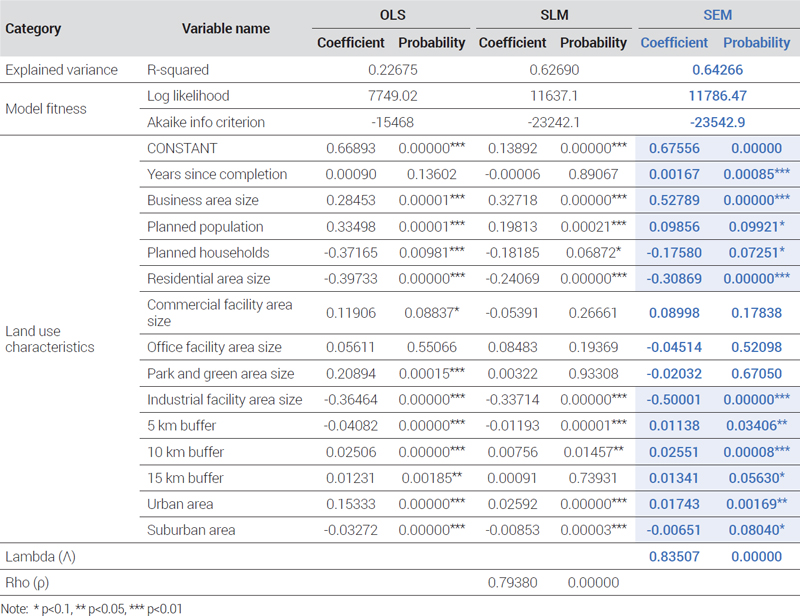
Final publication date 05 Jul 2024
An Analysis of the Effect of Land Development Projects on Urban Centrality and Spatial Structure : Focusing on the Land Development District in the Capital Area
Abstract
This study investigates the impact of land development projects on urban centrality and spatial structure in the Seoul Metropolitan Area (SMA), South Korea. Rapid urbanization and housing shortages since the mid-1980s prompted extensive land development aimed at addressing these issues and reshaping urban spatial dynamics. Using data from 2000 to 2020, this study analyzed variables including land price, population density, commercial and office facility areas, workforce size, and number of businesses to construct a centrality index. Spatial regression analysis highlighted the significant correlation between planned area and the centrality index, underscoring the planning area's pivotal role. The findings indicate a decrease in overall centrality index, with notable increases in regions exhibiting high centrality, particularly in Seongnam-Yongin-Suwon and Goyang-Paju. Policy recommendations emphasize the need for targeted urban planning and infrastructure development in these burgeoning areas. Strengthening transportation networks to enhance accessibility between these regions is crucial for fostering balanced urban growth. Conversely, established centers such as downtown Seoul and Yeouido require upgrades to existing infrastructure and the creation of new commercial and cultural spaces. Struggling areas like Incheon Michuhol and certain regions in Gyeonggi Province necessitate revitalization through strategic redevelopment initiatives. This research underscores the pivotal role of land development projects in shaping urban centrality and spatial structure. It offers critical insights for formulating effective urban policies to ensure balanced and sustainable urban growth in the SMA.
Keywords:
Land Development District, Centrality index, Urban Spatial Structure, Spatial Analysis키워드:
택지개발지구, 중심성지수, 공간구조, 공간회귀분석기법Ⅰ. Introduction
Korea’s rapid industrialization since the 1960s has led to accelerated urbanization, resulting in population growth and housing shortages in cities, especially in metropolitan areas. In response, the government enacted the “Housing Site Development Promotion Act” in 1981, and based on this, large-scale government-led housing site development projects have been underway since the mid-1980s. Housing site development zones, including new cities, have been created with the main purpose of alleviating housing shortages in urban areas, which has contributed to the stability of national housing and the promotion of welfare in accordance with the purpose of the law (Korean Law Information Center, 2023). Large-scale development, including these housing site development zones, brings about changes in the location of economic activities and settlements, and acts as one of the important factors affecting the spatial interaction between places. This promotes the reorganization of the urban spatial structure and greatly affects the formation of residents’ daily living areas.
The Seoul Metropolitan Area (SMA), which encompasses Seoul, Incheon, and Gyeonggi Province, accounts for 50.69% of the nation’s population (Statistics Korea, 2024) and is an active area for land development, with approximately 600 housing site development districts created within the SMA since the early 1980s. These large-scale developments have reshaped the spatial structure of the SMA and influenced regional growth. At the same time, however, they have led to depopulation in local cities and the decline of original city centers. The creation of large-scale housing site development districts, such as new cities, can affect the function of the center depending on their connectivity to existing cities, and their proper management and development contribute to regional development and balanced growth. While studies have been conducted on the effects of new development projects and the social and economic characteristics that affect changes such as population, there is still a lack of research on how housing site development projects have affected the centrality and spatial structure of the SMA.
Against this background, this study aims to analyze the impact of housing site development projects on urban centrality and spatial structure in the SMA (Table 1). Therefore, by measuring the changes in centrality and spatial structure before and after the establishment of housing site development districts and analyzing the factors that affect them, this study aims to understand the spatial pattern of housing site development and its interaction with spatial structure, and to provide basic data that can be used as a reference for future housing site development policies.
Ⅱ. Theoretical Considerations and Review of Previous Studies
1. Theoretical Considerations
Understanding urban spatial structures—which involve how urban areas performing various functions are spatially arranged and interact with each other—is crucial for managing these structures. The formation of urban space structures can be explained primarily from an urban economic perspective. This is based on the premise that the allocation and use of land are determined by rent competition, where land is allocated to users who can pay the highest rent. The processes of urban spatial structure and formation are explained by W. Burgess’s concentric zone theory and Harris and Ullman’s multiple nuclei theory, both of which rely on rent competition.
According to the concentric zone theory, urban spatial structure is shaped by five residential areas formed in concentric zones radiating from a central point—the central business district, where commercial and business functions are concentrated. Harris and Ullman, however, argued that it is impossible for central functions to be concentrated in a single center. They proposed the multiple nuclei theory, suggesting that central functions are divided among multiple centers of varying sizes, each performing separate and distributed functions, thereby forming a multi-nuclei urban structure. Based on this theory, the spatial dispersion of central functions can coexist with polycentric urban structures in many modern cities, which is desirable for efficient urban spatial structures.
The theory explaining the formation and characteristics of urban centers—where various central functions are concentrated—was first introduced by Christaller and later refined by Lösch. Christaller’s Central Place Theory posits that central places serve as hubs for producing and supplying central goods and services, which emerge from the agglomeration of businesses driven by urbanization. The size of the hinterland is uniformly determined by the reach of these goods and services, resulting in a hierarchical structure among areas.
This hierarchy differentiates higher-order from lower-order centers based on the threshold population or market range required by the goods and services they provide. This distinction is instrumental in shaping the hierarchical structure of areas.
Lösch expanded on Christaller’s theory by highlighting that each area’s services or functions have unique minimum requirements. He argued that while areas of the same order might offer a similar quantity of central goods and services, their specific functions are not necessarily identical. In the Central Place Theory, central goods and services refer to essential urban functions, such as administration, commerce, culture, business, and healthcare. To ensure an even distribution of these functions, modern cities regulate and promote the concentration of central functions through zoning that controls both density and building height.
Central Place Theory remains a foundational tool for analyzing urban centers including their functions and definitions. However, the concept of area is broad and subject to varying interpretations depending on the researcher. This variability suggests that the characteristics of areas can differ significantly based on the humanistic, social, and historical contexts of the urban area (Reconstructed from Kim et al., 2015 “Regional and Urban Economics” and Korea Planning Association, 2016 “Urban Planning Theory”).
2. Review of Previous Studies
Previous research on centrality and spatial structure has increasingly adopted population, transportation (networks), spatial regression analysis, and big data methodologies. These studies have sought to offer a more precise and practical understanding of urban spatial structure changes and centrality. Kim Ho-yong (2016) analyzed the patterns in spatial structure elements, providing significant insights in diagnosing and understanding changes in urban spatial structures. Jeong Da-woon (2015) highlighted that, within network systems, it is the functional connections between cities—rather than the absolute size of the centrality—that determine a city’s status and system. Ju Hyun-tae et al. (2022) conducted a survey to identify the commercial centrality of Bundang New Town and its surrounding areas, and verified that Bundang New Town has developed as a commercial center in the southern part of the SMA. Lee Soo-bin and Nam Jin (2021) adopted big data to analyze changes in urban spatial centrality in Seoul between 2011 and 2019, and the elements causing these changes.
Jang Young-ho (2010) applied spatial regression analysis methods, including grid analysis, centrality and standard deviation distance measurement, and spatial autocorrelation analysis (Moran’s I), to examine time-series changes in urban sprawl, population density, building density, employment density, and average land values, as well as spatial distribution patterns by function. These studies contribute to an in-depth understanding of urban spatial structure and centrality, providing a strong foundation for formulating the necessary policies for effective urban planning and management. They underscore the ongoing need for research on urban spatial structures and centrality, stressing the importance of using diverse analytical tools and methodologies.
Furthermore, land development plays a crucial role in shaping urban spatial structures. Kim Sung-hong (2015) demonstrated the importance of land development in comprehending the formation and transformation of urban spaces based on the interactions between external forces of cities and internal architectural principles, focusing on the case in Seoul’s Mokdong New Town. This highlights the interactions between urban planning and architecture in shaping and evolving urban spaces. Lee Hee-yeon and Shim Ji-hun (2006) proposed methodologies for measuring and comparing changes in spatial structure resulting from the urban growth in Yongin City from 1985 to 2005, offering valuable tools for analyzing spatial structure changes linked to urban growth and development. Jung Yeon-woo and Woo Myung-je (2020) categorized the types of target areas in the metropolitan area, excluding Seoul, analyzing population and employment changes to evaluate the impact of land development districts on neighboring cities. Furthermore, Kim Doo-hyun and Lee Ju-hyung (2002) analyzed spatial structure changes due to land development projects in Suwon and Yongin, reinterpreting issues arising from land development projects in terms of urban space and proposing policy alternatives tailored to each city’s spatial structure. Understanding the spatial distribution of land development and the following spatial structure changes is imperative for urban planning and policy-making. However, there is a limitation in most existing studies as they focus on individual cities or regions, with relatively few large-scale studies addressing areas with active land development, such as the metropolitan area.
This study introduces unique features through a novel approach to analyzing urban spatial structure and area formation, distinctive from previous research:
First, to set more precise and objective boundaries of area, the analysis was performed using a 1 km × 1 km grid unit. This method sets this study apart from existing studies that primarily relied on individual land development districts or administrative units such as city, county, district, and township-level units such as Eup-Myeon-Dong. This study achieved a more nuanced and accurate analysis by performing a spatial regression analysis of 148 land development districts exceeding 100,000 square meters, constructed between 2000 and 2020 in the SMA (Figure 1).
Second, the study examines urban areas and spatial structures in relation to the characteristics of land development districts. Unlike previous research that focused on individual cities or regions, this study aims to deeply understand the interaction between land developments and spatial structure. This approach elucidates the specific effects of land developments on urban spatial organization, enabling a more precise identification of area characteristics.
Third, areas are identified through the integrated use of spatial regression analysis and various spatial analysis techniques. Spatial regression yields more accurate results in spatial data analysis based on spatial autocorrelation. Additionally, various methods such as Moran’s I, Jenks Natural Breaks Classification, and K-means clustering were employed to analyze the characteristics and evolution of areas and spatial structures from multiple perspectives. This comprehensive approach facilitates a deeper, multidimensional comprehension of urban spatial dynamics.
Fourth, long-term changes and shifts in areas were analyzed using time series data, comparing the 2000 data with the 2020 data. As a result, changes in centrality were quantitatively assessed, evaluating the long-term impact of land developments on urban spatial structure. This again distinguishes this study from previous research that only focused on short-term analysis.
Fifth, the social and economic effects of land development projects were quantitatively assessed in this study. By applying spatial regression models, how the characteristics of land development districts—such as completion year, planned area, residential area, and industrial facility area—affected the centrality index was quantitatively analyzed, revealing the specific effects of land development on urban centrality. This is another feature of this study that offers a contrast to earlier studies that predominantly focused on qualitative analysis.
In conclusion, this study sets itself apart from existing studies by adopting a macro-regional perspective in setting analysis units, examining the interaction between areas, spatial structures, and land development districts, employing a range of spatial analysis techniques, and evaluating long-term effects through time series analysis. With these distinctive features, this study provides practical and detailed data vital for urban planning and policy-making, proposing more effective urban management strategies.
III. Analytical Framework
1. Research Scope and Flow
In this study, 148 land development districts completed between 2000 and 2020 in the SMA were set as the spatial scope, and areas and spatial structures encompassing Seoul, Incheon, and Gyeonggi Province were evaluated using 13,033 grid cells of 1 km × 1 km. The temporal scope of this study includes 2020, the most recent year with available big data, and the year 2000, twenty years prior. The content scope was set based on the assumption that land development affects urban centrality.
The study proceeds in three stages to examine urban spatial structure, area formation, and the effects of land development on areas. First, critical variables for identifying areas were investigated to obtain the centrality index by reviewing existing literature. The first spatial regression analysis was performed to calculate the centrality index using land price, population density, total floor area of commercial and office facilities, number of employees, and number of businesses as critical variables for identifying the areas. Second, to identify the boundaries and hierarchical structure of areas, the study conducted spatial autocorrelation measurement (Local Moran’s I), area identification (Jenks Natural Breaks Classification), and cluster analysis (K-means clustering) to determine the characteristics and changes within clusters.
Third, variables related to land development districts were identified through prior research to assess the impact of land development, and the second spatial regression analysis was performed to understand how land attributes impact the centrality index. Through this structured approach, the study aims to foster a comprehensive understanding of the changes in urban spatial structure and centrality, exposing the specific impacts of land development on urban spatial organization. The findings offer vital data for urban planning and policy-making. The overall research flow is illustrated in <Figure 2>.
As a foundational premise, this study defines central areas by integrating theoretical review and prior research, focusing on central areas within the SMA. Central areas are situated at the core of urban areas with highly concentrated commercial and business activities. In these areas, goods and services are produced and supplied more efficiently compared to other areas, leading to higher land values and rental rates as a result of fierce competition for space. A central area is a spatial area with a relative spatial advantage in terms of the concentration of central functions, development density, and land value.
2. Stage 1: Calculation of Centrality Index
This section reviews previous studies to identify the variables and methods adopted to determine central areas (Table 2). Commonly used variables in earlier research include land prices, commercial facilities, population density, floating population, number of employees, number of businesses, and traffic volume. For the comprehensive review of theoretical considerations and previous studies, a spatial regression analysis was performed to identify highly correlated variables among land prices, population density, commercial facility area, office facility area, number of employees, number of businesses, traffic volume, and subway ridership for creating the centrality index.
Land price was chosen as the dependent variable in this section to calculate the centrality index. Land price reflects the value of a corresponding site and various factors, including land use regulations, locational attributes, and scale, determining the land price are considered. The areas with higher land prices due to high locational potential typically include commercial and office functions (i.e., area functions). Because of these characteristics, land price is a metric fit for identifying areas. Therefore, the average official land price per grid cell was calculated and used as the indicator. As for independent variables, population density (as a social indicator), commercial and office facility areas (as physical indicators), number of employees and businesses (as industrial indicators), and traffic volume and subway ridership (as traffic indicators) (Table 3) are applied.
Previous studies have often relied on one or more indicators to identify areas. This approach typically involves identifying areas based on the mean values or specific quantiles in overlapping regions and then designating those areas that exceed a specific limit as central areas.
This study identified the dependent variable, land price, and indicators with a strong correlation to the dependent variables among the independent variables. The coefficients of each variable were multiplied and then added together to determine the centrality index. In addition, variables representing central area characteristics are calculated at the grid-unit level, which is the basis for our analysis.
All variables were identified based on the annual average changes between 2000 and 2020, and normalized to establish the centrality index with the Min-Max method. This method removes the data units and corrects the range of all data between 0 and 1, allowing the index calculation. Equation 1 shows the centrality index after each indicator is normalized.
| (1) |
3. Stage 2: Derivation of Boundaries and Hierarchical Structure of Central Areas
To measure spatial autocorrelation, both a global and local autocorrelation index, Moran’s I Index is calculated. Moran’s I is a tool used to assess the degree of similarity between a region’s value and those of neighboring areas, thereby identifying spatial patterns. Anselin (1995) designed the Local Indicators of Spatial Association (LISA) to understand spatial relationships at a local level. LISA is used to measure the local characteristics of spatial association. The formula for Local Moran’s I is shown in Equation 2 (Lee Hee-Yeon & Noh Seung-Chul, 2013).
| (2) |
The Local Moran’s I specifically examines spatial clustering patterns in areas with statistical significance, identifying the cluster of high-valued centrality index as central areas in the SMA. This index measures spatial autocorrelation, indicating whether a region’s attribute value is affected by interactions with neighboring areas. The index values range from -1 to 1. Local Moran’s is used in clearly defining central areas and their boundaries within the SMA.
Jenks Natural Breaks Classification was employed to identify central areas. This technique optimally categorizes data by identifying natural groupings within the dataset, minimizing variance within clusters while maximizing variance between clusters, effectively reflecting the data’s distribution characteristics (Jenks, 1967) Through this technique, the central areas were classified and their changes between 2000 and 2020 were analyzed. Furthermore, the distribution of central areas within the SMA was evaluated and a detailed analysis of the relationships and functional roles among these central areas was performed.
K-means clustering analysis was performed to examine the characteristics and changes of clusters. This technique is an unsupervised learning algorithm that groups data into multiple clusters. First, it randomly selects centroids, and each data point is assigned to the nearest centroid. The mean value of the assigned points is then obtained to calculate a new centroid, and this process is repeated until the centroids remain unchanged (Norušis, 2011). K-means clustering is well-suited for analyzing the functional roles of each central area by deriving the hierarchical structure of central areas. This method was applied to identify the hierarchical structure of central areas within the SMA and to examine the interrelations and functional roles of central areas. Equation 3 shows the formula for K-means clustering.
| (3) |
4. Stage 3: Analysis of Impact of Land Development
Land information is categorized into attribute data composed of information on project districts that is sourced from the Land Information System and spatial data, which is map-based information. This study focused on 148 land development districts out of roughly 600 districts in the SMA, including new towns, each exceeding 100,000 square meters, that were fully constructed or partially completed between 2000 and 2020.
Attribute information related to the land development such as planned population, planned households, development zone area size, and years since completion have been set as the indicators. The area sizes of residential area, commercial and office facilities, and park and green areas from the Land Information System were used as the indicators.
The primary objective of this section is to assess the impact of land development on central areas and spatial structures within the SMA. <Table 4> shows the dependent and independent variables where the dependent variable is the change in the centrality index, and the independent variables is the land use characteristics and dummy variables.
In this stage, a spatial regression analysis combined with the spatial join to a grid unit was conducted to evaluate the impact of the land use characteristics, the independent variables, while the centrality index derived from the earlier indicators, was used as the dependent variable. This approach allowed for comparison of the main statistics of OLS, SLM, and SEM models with the independent variables to analyze the effectiveness of the spatial regression model. Further, the centrality and spatial structure changes before and after the land development are measured, and the factors affecting these changes are identified.
OLS (Ordinary Least Squares) is a basic regression analysis tool that estimates the linear relationship between independent and dependent variables by minimizing the sum of squared differences. While OLS effectively analyzes relationships between variables, it has limitations when analyzing data with spatial autocorrelation. To overcome this limitation of spatial autocorrelation, the Spatial Lag Model (SLM) adds a spatially lagged dependent variable into the regression formula to take into account the influence of neighboring observations. On the contrary, the Spatial Error Model (SEM) accounts for spatial autocorrelation in the error terms to perform modeling the correlation between errors and adjacent observations. Both spatial regression models offer a more reliable analysis by accurately reflecting spatial dependencies. The programs used to construct spatial information of variables in this analysis included Python, QGIS, and ArcGIS, while GeoDa was adopted to measure spatial autocorrelation, run OLS, SLM, and SEM models, and perform K-means clustering analysis.
Ⅳ. Analysis Results
1. Centrality Index Calculation Results
In this section, the land price change was used as the dependent variable, and 13,033 observations and nine variables were incorporated into the analysis. The OLS, SLM, and SEM models were analyzed, and the SEM model exhibited the highest explanatory power, with an R-squared value of 0.755852 (Table 5). The estimated spatial lag coefficient (Rho) was 0.750493, representing a strong spatial correlation among the dependent variables.
The Breusch-Pagan and likelihood ratio tests demonstrated that the model effectively captured heterogeneity and spatial dependence. The coefficient estimates and significance tests for the key variables found that the population density change (0.017232, p=0.00016), commercial facility area change (0.0837247, p=0.00000), office facility area change (0.027152, p=0.00000), number of businesses change (0.022475, p=0.02390), and the number of employees change (0.215483, p=0.00000) had significant positive impacts. On the other hand, changes in traffic volume and changes in subway ridership showed a non-significant negative impact and a significant negative impact, respectively.
| (4) |
Various variable selection methodologies, such as forward selection, backward elimination, and stepwise selection, were applied to select the optimal number of variables. In this study, forward selection was conducted to select six variables—land price, population density, commercial facility area, office facility area, number of employees, and number of businesses—as the components of the centrality index. The centrality index was then calculated using Equation (4), where the regression coefficients of the six selected variables served as weights. To be specific, the regression coefficient (0.26630) for land price change was determined by the regression analysis between the centrality index (X) and land price (Y).
2. Derivation Results of Central Area Boundaries and Hierarchical Structure
Analysis of the changes between 2000 and 2020 using the local Moran’s I index revealed a decline in the Moran’s I value from 0.748 in 2000 to 0.722 in 2020. The number of High-High (HH) areas rose from 931 to 1,030 and Low-Low (LL) areas increased from 4,289 to 5,089. In contrast, Low-High (LH) areas decreased from 63 to 57 and High-Low (HL) areas dropped from 2 to 0.
A notable development in 2020 was the expansion of boundaries to include Seongnam, Yongin, and Suwon, south of Seoul, leading to urban conurbation. The local Moran’s I index for central area changes showed that High-High areas correspond to central areas, Low-Low areas to legally restricted development areas, Low-High areas to regions such as the Han River, hilly terrains, and urban parks, while High-Low areas correspond to locations for Incheon Airport, industrial complexes, and logistics centers (see Figures 3 and 4).
Identifying central areas using the Jenks Natural Breaks Classification showed an overall increase in areas of high centrality from 2000 to 2020. In particular, the first quintile decreased from 12,024 to 11,670, while the second quintile rose from 517 to 804, the third from 365 to 421, the fourth from 113 to 117, and the fifth from 14 to 18.
In terms of location, significant changes were observed along the Gyeongbu Expressway axis in southeastern Seoul, particularly the Seongnam-Yongin-Suwon area. Furthermore, while the northwest regions of Goyang and Paju remain in the low quintile, there are clear signs of gradual expansion. Within Seoul, the traditional city center and Yeouido have seen either minimal changes or a reduction in centrality, whereas the centrality of the Seocho and Gangnam districts has intensified (Figure 5).
In this section, a K-means cluster analysis was performed to categorize urban areas in 2000 and 2020 into five distinct clusters and examine their characteristics and changes over time. The number of clusters was determined through the Elbow Method, and five clusters that minimized the within-cluster sum of squares (WCSS) were selected (Figure 6).
The variables used in this analysis included the land price, population density, commercial facility area, office facility area, number of employees, and number of businesses, as well as the centrality index estimated for each year. The analysis of cluster characteristics and their changes shows the following (Table 6, Figure 7).
Cluster C1 (Non-central areas) showed little change in most variables between 2000 and 2020, with both land price and centrality index remaining almost unchanged. The cluster size slightly reduced from 12,094 to 11,904, representing that C1 areas do not serve as central areas.
Cluster C2 (Small commercial area) experienced significant population, commercial facilities, and employment increases, particularly in population growth. The cluster size expanded substantially from 499 to 747, indicating a continued growth of C2, the small commercial area.
Cluster C3 (Developing commercial area) exhibited growth in commercial facilities and employment with a slight decline in the centrality index. The cluster size shrunk from 345 to 318, implying that C3 area is developing as a commercial center.
Cluster C4 (Changing commercial area) demonstrated growth in most variables, particularly in employment and centrality index. The cluster size significantly reduced from 83 to 54, indicating a reorganization of mid-tier commercial areas.
Cluster C5 (Major commercial center) displayed little change across most variables, with a slight decrease in the centrality index. The cluster size marginally reduced from 12 to 10, maintaining its status as a major commercial center.
In terms of the statistical robustness of the cluster analysis, the total sum of squares (SS) remained consistent at 91,224 across both time points. However, the WCSS rose from 15,928 in 2000 to 19,493.3 in 2020, whereas the between-cluster sum of squares (BCSS) dropped from 75,296 to 71,730.7. Therefore, the ratio of the between-cluster sum of squares to the total sum of squares (BTSS/Total SS) decreased from 0.825397 in 2000 to 0.786314 in 2020.
This shows that variance within clusters has increased while the differences between them have narrowed, indicating that the characteristics of different urban areas have become more mixed and diversified over time (Table 7).
In addition, a comparative analysis of the changes and movements in centrality between 2000 and 2020 was performed for the clusters C4 and C5, which show high centrality. The centroids of these clusters were identified and visualized, and their movement distances were measured (Figure 8).
The analysis revealed that in Cluster C4, there was a noticeable movement or decrease of centrality in areas located on the outskirts of Seoul, such as Nowon-gu,Gangdong-gu–Gwangjin-gu–Dongdaemun-gu, and Yangcheon-gu–Guro-gu–Gwanak-gu. Conversely, districts such as Gangseo-gu, Mapo-gu, Seongdong-gu, Songpa-gu, Gangnam-gu, Seocho-gu, Geumcheon-gu, and Yeongdeungpo-gu saw an increase in centrality. In Incheon, centrality decreased in Michuhol-gu and Namdong-gu, whereas it rose in Bupyeong-gu. In Gyeonggi Province, centrality decreased in Uijeongbu-si, Guri-si, Sujeong-gu in Seongnam-si, Paldal-gu in Suwon-si, Pyeongtaek-si, Dongan-gu in Anyang-si, Danwon-gu in Ansan-si, and Bucheon-si, while Ilsandong-gu in Goyang-si, Bundang-gu in Seongnam-si, and Manan-gu in Anyang-si saw a stronger role of central areas. These developments in Cluster C4 indicate a reconfiguration of the urban spatial structure, with some movements and size changes of central areas.
In Cluster C5, there was almost no change in the central areas of the three key areas of Seoul—Seoul’s city center, Yeouido, and Gangnam—with the city center shrinking by a mere 2 km2 and Gangnam by 1 km2. High centrality was observed in the Sanggye-Jangam urban development district near Dobongsan Station, located on the border between Dobong-gu and Nowon-gu.
In terms of change in movement distance, the average movement distance for the 26 clusters in Cluster C4 was 16.316 km, and 1.171 km for the four clusters in Cluster C5.
3. Analysis of the Land Development Effects
This section analyzed the effects of land development using the land use characteristics—years since completion, business area size, planned population, planned households, residential area size, industrial facility area size, and proximity to the city center (within 5 km, 10 km), urban area, and suburban area—as the independent variable and the centrality index as the dependent variable (Table 8). As a result of the regression analysis using the Spatial Error Model (SEM), the model fitness and explanatory power were found to be high, with the spatially correlated errors (Lambda) of 0.835068, indicating that spatial autocorrelation was accounted for in the model (p<0.00001).
The residential area size had a significantly negative impact on the centrality index (p<0.00001), as did the industrial facility area size (p<0.00001). Conversely, distance of 5 km and 10 km from the district center significantly positively affected the centrality index (p=0.03406, p=0.00008). The urban area also had a significant positive impact on the centrality index (p=0.00169).
The regression model’s R-squared value was 0.642659, demonstrating that the variance in the dependent variable is approximately 64.3% explained by the independent variables. The log-likelihood was 11786.473750, with an Akaike Information Criterion (AIC) of -23542.9 and a Schwarz Criterion (SC) of -23430.8. The regression analysis also revealed the presence of heteroscedasticity, as seen by the Breusch-Pagan test p-value of 0.00000. The Likelihood Ratio Test for spatial error dependence confirmed significant spatial error dependence (p=0.00000). Overall, among the variables, the planned area showed the strongest correlation with the centrality index, while the year since completion, residential area size, industrial facility area size, and urban area also had significant effects on the centrality index. The strong correlation between the planned area of land development districts and the centrality index indicates that land use planning is crucial in defining centrality. Further, the positive effects of 5 km and 10 km buffers on the centrality index emphasize the importance of proximity to the central area.
Ⅴ. Conclusion and Implications
This study analyzed the impact of land development districts in the Seoul Metropolitan Area (SMA) on urban centrality, offering insights by identifying areas where centrality was established. First, we constructed the centrality index using six key variables selected through a variable selection method: land prices, population density, commercial area size, office area size, number of employees, and number of businesses. These findings indicate that these variables are crucial in calculating centrality, with the planned area showing a particularly strong correlation with the centrality index.
To measure spatial autocorrelation, local Moran’s I analysis was conducted to understand the change of the Moran’s I index over time and the distribution of the spatial structure. Notably, both High-High and Low-Low clusters grew, with the High-High areas increasing from 931 to 1,030 and the Low-Low areas increasing from 289 to 5,089. Furthermore, the Jenks Natural Breaks Classification identified an intensified centrality along the Gyeongbu Expressway corridor, particularly in Seongnam, Yongin, and Suwon, as well as within Seoul’s Seocho-gu and Gangnam-gu in 2020 compared to 2000.
K-means clustering analysis was performed on five clusters to analyze cluster characteristics and changes. It discovered increased centrality in the small commercial area (C2) and developing commercial area (C3), while the major commercial center (C5) maintained its centrality. Finally, to understand the impact of land development districts, we investigated variables from previous studies. The attributes of the land development districts include years since completion, planned area, residential area size, and industrial area size. Spatial regression analysis showed that the years since completion and planned area positively affected the centrality index, while residential and industrial area sizes had a negative impact. Notable areas experiencing changes in centrality include the Seongnam-Yongin-Suwon corridor and Seoul’s Seocho-gu and Gangnam-gu, whereas centrality in Seoul’s city center and Yeouido remained unchanged or declined.
As mentioned above, this study analyzed the impact of large-scale development projects such as land development districts in the SMA on urban centrality and spatial structure. As a result, the following five considerations should be kept in mind when establishing similar development policies in the future.
First, careful adjustment of the planned area is required to achieve balanced urban growth. Given the strong correlation between planned area and centrality, future land development plans should establish appropriate planned areas in each district to promote balanced urban expansion. With this approach, excessive concentration in certain areas can be avoided and overall urban structural balance can be maintained. In addition, transportation infrastructure should be improved to enhance access to major central areas. With strengthened centrality in the Seongnam-Yongin-Suwon and Goyang-Paju regions, enhancing the transportation networks connecting these areas will be crucial in enhancing regional connectivity.
Second, regional characteristics should be taken into account when establishing development strategies. In other words, it is necessary to establish a development strategy tailored to the region by reflecting the location characteristics of the region, including land prices, social indicators, physical indicators, and industrial indicators derived from the study. For example, assuming that there are areas with increasing centrality of small and medium-sized commercial areas (C2) and developing commercial areas (C3), you can consider specializing in these areas by intensively developing commercial and office facilities to further strengthen their centrality. In addition, reflecting the phenomenon of mixing and diversifying the characteristics and uses of different areas within a city, it is necessary to adopt various approaches such as mixed land use or mixed-use development rather than a single development approach based on the existing zoning system.
Third, policy support for high centrality areas is needed. Areas with high centrality, such as Seongnam, Yongin, Suwon, and Seocho-gu, Gangnam-gu, and Seongnam-gu, need to expand infrastructure and commercial facilities to consolidate their roles as existing commercial and business centers. In addition, high-tech industries and business hubs should be established in areas with high centrality, excluding the Seoul city center, to create an industrial, commercial, and business ecosystem that can serve as a driving force for economic growth in the region. This will require multifaceted efforts, such as fully implementing policies to attract and support innovative companies and investing in research and development.
Fourth, revitalization of areas with low centrality is required. In other words, in areas identified as having low centrality, such as Uijeongbu-si, Guri-si, Sujeong-gu, Seongnam-si, and Michuhol-gu, Incheon-si, which are represented by the original city centers, redevelopment and reconstruction of aging residential and commercial areas should be carried out using comprehensive redevelopment and urban regeneration techniques according to local characteristics and circumstances, and the quality of life of residents in the original city centers should be improved through the creation of anchor facilities such as cultural spaces and community facilities and life SOCs. In addition, eco-friendly and sustainable redevelopment or urban regeneration models should be developed and introduced, such as creating a pleasant urban environment by expanding parks and green spaces that are lacking in low-rise residential centers.
Finally, it is necessary to set a long-term and flexible development direction. In other words, since we have seen that large-scale development, such as land development projects, affects the existing urban centers and spatial structure, it is necessary to set a development direction that takes into account local and cultural characteristics through phased and flexible development plans rather than short-term rapid development as in the past. In addition, it is necessary to respond to a future society in which the population is expected to decline rapidly due to the gradual entry into an ultra-elderly society and a declining birthrate, and therefore, the method of creating large-scale residential development through the lifting of development restrictions should be gradually avoided or reconsidered.
Overall, this study analyzed the impact of residential development projects on the urban spatial structure and centrality of the metropolitan area from a broad scope of the entire metropolitan area, and as a result, the areas where the centrality and spatial structure of the metropolitan area have changed were specifically presented and visualized. This suggests that when establishing urban plans and policies as described above, it is important to consider customized policies appropriate to the region, including strategic approaches to support and revitalize sustainable development based on high and low centrality.
Limitations of the study include limited data, which did not fully reflect some variables between or within variables, and the analysis period covered only a relatively short period of time compared to the entire period of land development, which limits the ability to identify changes in urban spatial structure. Future research should address these shortcomings and utilize a wider range of variables and longer-term data to produce more sophisticated analytical results. On the other hand, it would be more meaningful to conduct similar studies in other regions other than the Seoul metropolitan area and analyze them comparatively, so that we can derive national urban development patterns and implications.
In particular, it would be meaningful to use advanced technologies such as machine learning to predict future urban spatial structures, or to use time-series analysis to fully consider the time required for a land development project to fulfill its role as the center of a city after it is completed. If such a study is conducted as a follow-up study, it will be able to draw important implications in the discussion related to urban development, and furthermore, it will be able to make important contributions to urban planning and policy formulation.
Acknowledgments
This work is supported by the Korea Agency for Infrastructure Technology Advancement (KAIA) grant funded by the Ministry of Land, Infrastructure and Transport (Grant RS-2022-00143404).
References
-
Anselin, L. 1995. “Local Indicators of Spatial Association—LISA”, Geographical Analysis, 27(2): 93-115.
[https://doi.org/10.1111/j.1538-4632.1995.tb00338.x]

-
Choi, J.Y., Park, M.Y., and Kang, J.E., 2022. “Assessment of Busan City Central Area System and Service Area Using Machine Learning and Spatial Analysis”, Journal of the Korean Association of Geographic Information Studies, 26(3): 65-84.
최지윤, 박민영, 강정은, 2023. “머신러닝과 공간분석을 활용한 부산시 중심지 체계 및 영향권 분석”, 「한국지리정보학회지」, 26(3): 65-84. -
Hwang, E.C., Kim, M.S., and Park, J.Y., 2013. “A Study on the Boundary-setting of the New and Old Central Districts in Daejeon Metropolitan City”, The Geographical Journal of Korea, 47(3): 263-274.
황의창·김민수·박진영, 2013. “대전시 신·구도심의 경계설정에 관한 연구, 「국토지리학회지」, 47(3): 263-274. -
Jang, Y.H., 2010. “Measurement of the Changes in Urban Spatial Structure by the Urban Sprawl and the Compactness Growth”, Ph. D. Dissertation, Hanyang University.
장영호, 2010. “도시의 내연적 성장과 외연적 성장에 따른 공간구조변화 측정에 관한 연구”, 한양대학교 박사학위논문. - Jenks, G.F., 1967. “The Data Model Concept in Statistical Mapping”, International Yearbook of Cartography, 7: 186-190.
-
Jeong, D,W., 2015. “Analyzing Formation and Transition Factors of Urban Spatial Structure with Networks”, Ph. D. Dissertation, Hanyang University.
정다운, 2015. “네트워크 도시공간구조 형성 및 변화요인 분석”, 한양대학교 박사학위논문. -
Jeong, Y.W. and Woo, M.J., 2020. “The Effect of Residential Development Project by Neighboring Eup-Myeon-Dong Unit”, Paper represented at the Korean Regional Development Association’s International Seminar in 2020, 128-138.
정연우·우명제, 2020. “택지개발이 인접한 읍면동에 미치는 영향: 경기·인천 지역을 대상으로”, 한국지역개발학회 2020년 국제학술대회, 128-138. -
Joo, H.T, Lee, C.M., and Lee, S.G., 2022. “A Study on Changes in Commercial Centrality in a New Town through Analysis of Commercial Goods Purchasing Behaviour: Focused on Bundang New Town (2000-2015)”, Journal of Korea Planning Association, 57(1): 5-25.
[
https://doi.org/10.17208/jkpa.2022.02.57.1.5
]

주현태·이창무·이수기, 2022. “상품 구매행태 분석을 통한 신도시 상업 중심성 변화 연구: 분당 신도시를 중심으로(2000-2015)”, 「국토계획」, 57(1): 5-25. -
Kim, C.S. and Woo, M.J., 2000. “The Hierarchy of Centers and Their Characteristics in Seoul”, Journal of Korea Planning Association, 35(1): 17-29.
김창석·우명제, 2000. “서울시 중심지 설정과 중심지 특성에 관한 연구”, 「국토계획」, 35(1): 17-29. -
Kim, D.H. and Lee, J.H., 2002. “A Study on the Characteristics of Change in Urban Space Structure due to Large Residential Development Project”, Journal of Korea Planning Association, 37(5): 87-99.
김두현·이주형, 2002. “대규모 택지개발사업에 따른 도시공간구조 변화특성에 관한 연구”, 「국토계획」, 37(5): 87-99. -
Kim, E.J., Kim, J.H., Kim, H.Y., Koo, G.J., Ma, G.R., Lee, S.G, and Im, U., 2015. Regional Urban Economics, Seoul: Hongmunsa.
김의준·김재홍·김호연·구교준·마강래·이수기·임업, 2015. 「지역·도시경제학」, 서울: 홍문사. -
Kim, H.Y., 2016. “Simulation of Land Use Change by Storylines of Shared Socio-Economic Reference Pathways”, Journal of the Korean Association of Geographic Information Studies, 19(2): 1-13.
[
https://doi.org/10.11108/kagis.2016.19.2.001
]

김호용, 2016. “사회경제 경로 시나리오에 따른 토지이용 변화 시뮬레이션”, 「한국지리정보학회지」, 19(2): 1-13. -
Kim, H.Y., Kim, J.S., and Lee, S.H., 2012. “A Spatial Statistical Approach to the Delimitation of CBD”, Journal of the Korean Association of Geographic Information Studies, 15(4): 42-54.
[
https://doi.org/10.11108/kagis.2012.15.4.042
]

김호용·김지숙·이성호, 2012. “도심경계설정을 위한 공간통계학적 접근”, 「한국지리정보학회지」, 15(4): 42-54. -
Kim, S.H., 2015. “Housing Site Development and a Shift in Urban Architecture at Mok-dong in Seoul”, The Journal of Seoul Studies, 59: 125-162.
[
https://doi.org/10.17647/jss.2015.05.59.125
]

김성홍, 2015. “택지개발사업과 서울 목동 신시가지 도시건축의 변화”, 「서울학연구」, 59: 125-162. -
Korea Planning Association, 2016. Urban Planning Theory, Seoul: Boseonggak.
대한국토·도시계획학회, 2016. 「도시계획론」, 서울: 보성각. - Kruger, S.G., 2012. “Delimiting the Postmodern Urban Center: An Analysis of Urban Amenity Clusters in Los Angeles”, M.S. Dissertation, University of Southern California.
-
Lee, D.H. and Park, D.H., 2011. A Study on Urban Spatial Structure and Establishment of the Central Place in Busan, Journal of The Korean Data Analysis Society, 13(1): 365-375.
이동현·박동현, 2011. “부산의 도시공간구조와 중심지 설정에 관한 연구”, 「한국자료분석학회지」, 13(1): 365-375. -
Lee, H.Y. and No, S.C., 2013. Advanced Statistical Analysis, Goyang: Moonwoosa.
이희연·노승철, 2013. 「고급통계분석론」, 고양: 문우사. -
Lee, H.Y. and Sim, J.H., 2006. “A Measurement of the Spatial Structural Change by the Urban Growth: A Case of Yongin-Si”, Journal of the Korean Urban Geographical Society, 9(2): 15-29.
이희연·심지헌, 2006. “도시성장에 따른 공간구조 변화 측정에 관한 연구: 용인시를 사례로 하여”, 「한국도시지리학회지」, 9(2): 15-29. -
Lee, S.B. and Nam, J., 2021. A Study on the Changes in Urban Space Centrality and Its Influences in Seoul : Focused on 2011 and 2019, Journal of Korea Planning Association, 56(6): 22-35.
[
https://doi.org/10.17208/jkpa.2021.11.56.6.22
]

이수빈·남진, 2021. “서울시 도시공간 중심성의 변화와 그 요인분석: 2011년과 2019년을 중심으로”, 「국토계획」, 56(6): 22-35. -
Lim, Y.S. and Lee, C.S., 2016. “Center Boundary Delimitation in Seoul Metropolitan Area Using Census Output Data”, The Korea Spatial Planning Review, 91: 109-124.
[
https://doi.org/10.15793/kspr.2016.91..007
]

임영식·이창수, 2016. “서울시 중심지 설정에 관한 연구”, 「국토연구」, 91: 109-124. -
Nam, Y.W., 1976. “Delimitation of the CBD by Land Values and Analysis of Land Value Distribution Patterns – A Case of Seoul City–”, Journal of Geography Education, 6: 51-78.
남영우, 1976. “지가에 의한 CBD 설정과 지가분포의 유형 분석 – 서울시의 경우 –”, 「지리교육논집」, 6: 51-78. - Norušis, M., 2011. “Cluster Analysis”, IBM SPSS Statistics 19 Statistical Procedures Companion, : 375-404.
-
Ok, S.M. and Lee, M.H., 2008. “A Study on the Establishment and the Change of Central Place System –A Case Study on Incheon Metropolitan City–”, Journal of The Korean Urban Management Association, 21(1): 107-125.
옥석문·이명훈, 2008. “중심지 체계설정 및 변화과정에 관한 연구 –인천광역시를 대상으로 하여–”, 「도시행정학보」, 21(1): 107-125. -
Yoo, E.J. and Jun, M.J., 2019. “An Analysis on the Dynamics and Characteristics of Employment Centers in the Seoul Metropolitan Area”, Journal of The Korean Regional Development Association, 31(4): 219-236.
유의진·전명진, 2019. “수도권 고용 중심지 변화 및 입지 특성 분석”, 「한국지역개발학회지」, 31(4): 219-236. -
Korean Law Information Center, 2023. Housing Site Development Promotion Act, https://www.law.go.kr/법령/택지개발촉진법
국가법령정보센터, 2023. “택지개발촉진법”, https://www.law.go.kr/법령/택지개발촉진법 -
Statistics Korea, 2024. 07. 29., “2023 Population and Housing Census”, https://www.kostat.go.kr/board.es?mid=a10301010000&bid=203&act=view&list_no=431972
통계청, 2024. 07.29., “2023 인구주택총조사”, https://www.kostat.go.kr/board.es?mid=a10301010000&bid=203&act=view&list_no=431972




